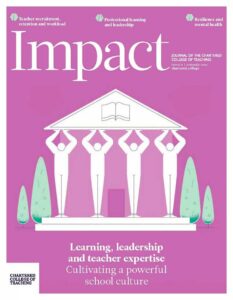How reducing teacher workload can improve student outcomes

At Charles Dickens Primary School, we have been working for five years to reduce teacher workload. We started with written marking and have subsequently addressed planning, displays, reporting to parents and writing assessment. Over this period, we have seen student outcomes improve in English and maths and, more recently, in foundation subjects. Teachers report to us that they have the freedom to focus on developing their practice and on actions that have a strong positive impact on the students in their classes. Charles Dickens retained its ‘Outstanding’ judgement following an inspection in September 2019, and the average combined reading, writing and maths outcomes over the last three years are more than 20 percentage points higher than national figures.
Our journey to reduce teacher workload started almost by accident. In 2015, teachers started a Journal Club, in which staff met on a termly basis to explore a piece of educational research. In spring 2016, we discussed the Education Endowment Foundation’s A Marked Improvement – a Review of the Evidence on Written Marking (Elliott et al., 2016). One statement in particular struck a chord: ‘Given… the huge amount of time currently invested in marking, it is essential to ensure that marking is as efficient and impactful as possible.’ (p. 4)
Teachers overwhelmingly felt that written marking was taking a disproportionate amount of their time, without the corresponding effect on student outcomes. Their frustration was less about their workload per se and more about ensuring that this workload was purposeful.
The findings of A Marked Improvement were supported by the Independent Teacher Workload Review Group’s Eliminating Unnecessary Workload Around Marking (2016). This report included some bold and resonant statements, in particular: ‘Marking practice that does not have the desired impact on pupil outcomes is a time-wasting burden for teachers that has to stop.’ (p. 3)
The following September, the National College for Teaching and Leadership invited bids from groups of schools to lead research projects into one of the three areas highlighted in the Workload Challenge. Following the clarion call from A Marked Improvement that ‘There is an urgent need for more studies so that teachers have better information about the most effective marking approaches’ (2016, p. 5), Charles Dickens submitted a proposal to work with other primary schools in Southwark to investigate the impact on teacher workload and student outcomes of completely removing distance written marking in English and mathematics.
The project schools replaced written marking with:
- self- and peer-assessment
- verbal feedback within the lesson
- conferencing after the lesson.
The project was funded from January to July 2017 and covered teacher release time for training and check-in sessions, a formal evaluation from UCL Institute of Education, and dissemination of the findings. Each school had two intervention and two control classes, though these were not randomised. We used the first half-term to train teachers in alternative feedback strategies and for them to teach their students to self- and peer-assess accurately and honestly. The intervention ran from spring term two to summer term one. Teacher workload was measured through entry and exit surveys; student outcomes were measured using entry and exit age-standardised tests (GL Assessment’s Progress Tests in Maths) and through extensive writing moderation. The data analysis and project evaluation were conducted by UCL Institute of Education and published as Reducing Teacher Workload: Southwark Teaching School Alliance Research Report (Featherstone and Seleznyov, 2018). We invited parents to an information evening to explain the no-marking project, and their children’s books were shared at parents’ evening. At the end of the project, we shared the outcomes in a dissemination event. No concerns were raised by parents.
The key findings for our project were:
- Teacher workload was reduced by over six hours per week
- There was no impact on student outcomes: the progress of students in the intervention was not measurably different from that of those in the control group.
Four other groups of schools across England received funding to run projects exploring alternatives to written marking. The findings of all five groups were remarkably consistent, as seen in Table 1.
| Project and focus | Impact |
| Southwark TSA (5 primary schools)
Replaced written marking with a range of ‘live’ feedback approaches |
Reduced workload
No negative impact |
| Wigan Wows (15 primary schools)
Replaced written marking with verbal feedback, marking codes, peer- and self-assessment |
Reduced workload
No negative impact |
| Aquinas Trust (3 primary, 2 secondary, 1 special school)
Replaced written marking with verbal feedback |
Reduced workload
No negative impact |
| Cheshire Vale (3 secondary schools)
Replaced written marking with a range of ‘live’ feedback approaches |
Reduced workload
No negative impact |
| Flying High (16 nursery and primary schools)
Replaced written marking with a range of alternative feedback strategies |
Reduced workload
No negative impact |
Table 1: Findings from project schools
The project evaluations are listed in the References section (Herbert et al., 2018; Kime, 2018; Protsiv and Welch, 2018; Richardson et al., 2018).
Since 2017, we have honed our approaches to feedback and rewritten our feedback policies to remove any requirement for written marking. With the increased focus on the quality of feedback and on the immediacy with which students receive feedback, we have seen student outcomes in writing and maths improve year on year.
One senior leader from a participating school commented, ‘When it first came up, I thought it was the worst idea ever. Now I think it’s brilliant.’
And what do teachers do with that additional time saved from marking? They plan meaningful responses to the students’ work; they leave early to maintain their work–life balance; and they have more time and energy to spend on their professional growth.
Involvement with the project got us thinking more about teachers’ workload. In the past two years, we have made further changes:
- introducing a commercial scheme of work in maths and home-grown, fully resourced schemes in science and foundation subjects
- replacing displays with working walls
- replacing detailed narrative reports to parents with simple reporting of attainment and engagement data across all subjects
- using comparative judgementAn approach to marking where teachers compare two students’ responses to a task and choose which is better, then repeat this process with other pieces of work (nomoremarking.com) for writing assessment.
The impact of this work is monitored through staff workload and wellbeing surveys and, in 2019, through a peer review, in which we asked senior leaders from other schools to evaluate our progress. This found that teachers’ workload has reduced by about 10 hours per week. Data suggests that student outcomes have either remained high or improved.
Teachers’ time is finite. If we want the very best for our students, we need to allow teachers to focus on those activities with the greatest effect on student outcomes. By reducing workload in areas with little evidence of impact, we can realign teachers’ working lives with their moral purpose and improve both teacher wellbeing and student outcomes.
Jemima Rhys-Evans’s booklet Mark Less, Mark Better: A How-To Guide is available as a free download from researchschool.org.uk/public/docs/Mark-Less-Mark-Better-Autumn-2019-002.pdf.
References
Elliott V, Baird J, Hopfenbeck TN et al. (2016) A Marked Improvement? A Review of the Evidence on Written Marking. Oxford: Education Endowment Foundation.
Featherstone G and Seleznyov S with UCL Institute of Education (2018) Reducing Teacher Workload: Southwark Teaching School Alliance Research Report. London: Department for EducationThe ministerial department responsible for children’s services and education in England.
Herbert G, Oates T, Sherriff T et al. (2018) Reducing Teacher Workload: The WOWS Research Project. London: Department for Education.
Independent Teacher Workload Review Group (2016) Eliminating Unnecessary Workload Around Marking: Report of the Independent Teacher Workload Review Group. London: Department for Education.
Kime S (2018) Reducing Teacher Workload: The ‘Rebalancing Feedback’ Trial Research Report. London: Department for Education.
Protsiv R and Welch G (2018) Reducing Teacher Workload Through ‘Realtime’ Personalised Feedback Research Report, Aquinas Teaching and Learning Trust. London: Department for Education.
Rhys-Evans J and Field S (2017) Mark Less, Mark Better: A How-To Guide. London: South Teaching School Alliance.
Richardson R, Goodman O, Flight S et al. (2018) Reducing Teacher Workload: The Flying High Partnership Research Report. London: Department for Education.










